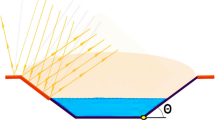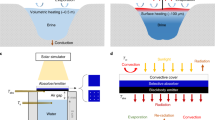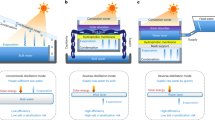Abstract
Solar-driven water evaporation is a sustainable method for obtaining clean water, but the use of high-salinity seawater as a by-product of the desalination process has not been exploited. Here we present an integrated desalination–power generation–cultivation trinity system. All from solar energy, we could obtain fresh water, electric power and crop cultivation media. During the water evaporation, from highly enhanced salinity gradient, reverse electrodialysis allowed for extracting electric power and the drainage could be used to water wheat. The long-running desalination–power generation–cultivation trinity system maintained an evaporation efficiency of ~1.42 kg m−2 h−1, achieving a peak power output of ~0.25 W cm−2. Through an agriculture integration platform, the drainage was found to be suitable for wheat cultivation, thus enabling the seamless combination of solar, oceanic and terrestrial energy sources. This study provides promising solutions and blueprints for alleviating global water/energy scarcity while achieving sustainable development.
This is a preview of subscription content, access via your institution
Access options
Subscribe to this journal
Receive 12 digital issues and online access to articles
$99.00 per year
only $8.25 per issue
Buy this article
- Purchase on Springer Link
- Instant access to full article PDF
Prices may be subject to local taxes which are calculated during checkout






Similar content being viewed by others
Data availability
All relevant data that support the findings of this study are presented in the article and Supplementary Information. Source data are provided with this paper. The data that support the findings of this study are openly available in Figshare repository with identifier (https://doi.org/10.6084/m9.figshare.23654583).
References
Rode, A. et al. Estimating a social cost of carbon for global energy consumption. Nature 598, 308–314 (2021).
Lian, X. et al. Multifaceted characteristics of dryland aridity changes in a warming world. Nat. Rev. Earth Environ. 2, 232–250 (2021).
Li, L. H. et al. Mitigation of China’s carbon neutrality to global warming. Nat. Commun. 13, 5315 (2022).
Boretti, A. & Rosa, L. Reassessing the projections of the World Water Development Report. npj Clean Water 2, 15 (2019).
Tong, D. et al. Committed emissions from existing energy infrastructure jeopardize 1.5 °C climate target. Nature 572, 373–377 (2019).
Xiao, X. X. et al. Tackling the challenges of enzymatic (bio)fuel cells. Chem. Rev. 119, 9509–9558 (2019).
Shannon, M. A. et al. Science and technology for water purification in the coming decades. Nature 452, 301–310 (2008).
Werber, J. R., Osuji, C. O. & Elimelech, M. Materials for next-generation desalination and water purification membranes. Nat. Rev. Mater. 1, 16018 (2016).
Li, X. Q. et al. Graphene oxide-based efficient and scalable solar desalination under one sun with a confined 2D water path. Proc. Natl Acad. Sci. USA 113, 13953–13958 (2016).
Zhang, R. N. et al. Antifouling membranes for sustainable water purification: strategies and mechanisms. Chem. Soc. Rev. 45, 5888–5924 (2016).
Im, S. J., Jeong, S. & Jang, A. Forward osmosis (FO)–reverse osmosis (RO) hybrid process incorporated with hollow fiber FO. npj Clean Water 4, 51 (2021).
Oviroh, P. O., Jen, T.-C., Ren, J. & van Duin, A. Towards the realisation of high permi-selective MoS2 membrane for water desalination. npj Clean Water 6, 14 (2023).
Mezher, T., Fath, H., Abbas, Z. & Khaled, A. Techno-economic assessment and environmental impacts of desalination technologies. Desalination 266, 263–273 (2011).
Li, Y. J. et al. 3D-Printed, all-in-one evaporator for high-efficiency solar steam generation under 1 sun illumination. Adv. Mater. 29, 1700981 (2017).
Shi, Y. et al. A 3D photothermal structure toward improved energy efficiency in solar steam generation. Joule 2, 1171–1186 (2018).
Wu, S. H. et al. Multifunctional solar waterways: plasma-enabled self-cleaning nanoarchitectures for energy-efficient desalination. Adv. Energy Mater. 9, 1901286 (2019).
Tao, P. et al. Solar-driven interfacial evaporation. Nat. Energy 3, 1031–1041 (2018).
Zhu, L. L., Gao, M. M., Peh, C. K. N. & Ho, G. W. Recent progress in solar-driven interfacial water evaporation: advanced designs and applications. Nano Energy 57, 507–518 (2019).
Chen, Q. M. et al. A durable monolithic polymer foam for efficient solar steam generation. Chem. Sci. 9, 623–628 (2018).
Logan, B. E. & Elimelech, M. Membrane-based processes for sustainable power generation using water. Nature 488, 313–319 (2012).
Yip, N. Y. & Elimelech, M. Thermodynamic and energy efficiency analysis of power generation from natural salinity gradients by pressure retarded osmosis. Environ. Sci. Technol. 46, 5230–5239 (2012).
Varcoe, J. R. et al. Anion-exchange membranes in electrochemical energy systems. Energy Environ. Sci. 7, 3135–3191 (2014).
Ji, J. Z. et al. Osmotic power generation with positively and negatively charged 2D nanofluidic membrane pairs. Adv. Funct. Mater. 27, 1603623 (2017).
Siria, A., Bocquet, M.-L. & Bocquet, L. New avenues for the large-scale harvesting of blue energy. Nat. Rev. Chem. 1, 0091 (2017).
Post, J. W. et al. Salinity-gradient power: evaluation of pressure-retarded osmosis and reverse electrodialysis. J. Membr. Sci. 288, 218–230 (2007).
Ramon, G. Z., Feinberg, B. J. & Hoek, E. M. V. Membrane-based production of salinity-gradient power. Energy Environ. Sci. 4, 4423–4434 (2011).
Huntington, H. P. et al. Applying the food–energy–water nexus concept at the local scale. Nat. Sustain. 4, 672–679 (2021).
Foley, J. A. et al. Global consequences of land use. Science 309, 570–574 (2005).
Chu, S. & Majumdar, A. Opportunities and challenges for a sustainable energy future. Nature 488, 294–303 (2012).
Godfray, H. C. J. et al. Food security: the challenge of feeding 9 billion people. Science 327, 812–818 (2010).
Ruan, C. P., Ai, K. L., Li, X. B. & Lu, L. H. A superhydrophobic sponge with excellent absorbency and flame retardancy. Angew. Chem. Int. Ed. 53, 5556–5560 (2014).
Gao, M. M., Zhu, L. L., Peh, C. K. & Ho, G. W. Solar absorber material and system designs for photothermal water vaporization towards clean water and energy production. Energy Environ. Sci. 12, 841–864 (2019).
Yu, X. W. et al. Graphene-based smart materials. Nat. Rev. Mater. 2, 17046 (2017).
Surwade, S. P. et al. Water desalination using nanoporous single-layer graphene. Nat. Nanotechnol. 10, 459–464 (2015).
Chen, J. X. et al. Janus evaporators with self-recovering hydrophobicity for salt-rejecting interfacial solar desalination. ACS Nano 14, 17419–17427 (2020).
Chen, X. et al. Sustainable off-grid desalination of hypersaline waters using Janus wood evaporators. Energy Environ. Sci. 14, 5347–5357 (2021).
Burada, P. S., Hanggi, P., Marchesoni, F., Schmid, G. & Talkner, P. Diffusion in confined geometries. ChemPhysChem 10, 45–54 (2009).
Lu, T. & Chen, F. Multiwfn: a multifunctional wavefunction analyzer. J. Comput. Chem. 33, 580–592 (2012).
Lin, C.-Y., Combs, C., Su, Y.-S., Yeh, L.-H. & Siwy, Z. S. Rectification of concentration polarization in mesopores leads to high conductance ionic diodes and high performance osmotic power. J. Am. Chem. Soc. 141, 3691–3698 (2019).
Siria, A. et al. Giant osmotic energy conversion measured in a single transmembrane boron nitride nanotube. Nature 494, 455–458 (2013).
Yang, P. H. et al. Solar-driven simultaneous steam production and electricity generation from salinity. Energy Environ. Sci. 10, 1923–1927 (2017).
Kumar, P. et al. Salinity stress tolerance and omics approaches: revisiting the progress and achievements in major cereal crops. Heredity 128, 497–518 (2022).
Almansouri, M., Kinet, J. M. & Lutts, S. Effect of salt and osmotic stresses on germination in durum wheat (Triticum durum Desf.). Plant Soil 231, 243–254 (2001).
Zhang, S. W., Gan, Y. T. & Xu, B. L. Application of plant-growth-promoting fungi Trichoderma longibrachiatum T6 enhances tolerance of wheat to salt stress through improvement of antioxidative defense system and gene expression. Front. Plant Sci. 7, 1405 (2016).
Jafar, M. Z. et al. Improving the performance of wheat by seed priming under saline conditions. J. Agron. Crop Sci. 198, 38–45 (2012).
Tang, W. J., Yang, K., Qin, J., Li, X. & Niu, X. L. A 16-year dataset (2000–2015) of high-resolution (3 h, 10 km) global surface solar radiation. Earth Syst. Sci. Data 11, 1905–1915 (2019).
Sweerts, B. et al. Estimation of losses in solar energy production from air pollution in China since 1960 using surface radiation data. Nat. Energy 4, 657–663 (2019).
Ozden, T. A countrywide analysis of 27 solar power plants installed at different climates. Sci. Rep. 12, 746 (2022).
Jacobson, M. Z. Review of solutions to global warming, air pollution, and energy security. Energy Environ. Sci. 2, 148–173 (2009).
Biswas, K. et al. High-performance bulk thermoelectrics with all-scale hierarchical architectures. Nature 489, 414–418 (2012).
Fan, F. R., Tian, Z. Q. & Wang, Z. L. Flexible triboelectric generator! Nano Energy 1, 328–334 (2012).
Wang, K. et al. Rational design of Spirulina residue-derived graphene oxide as an efficient metal-free catalyst for sulfathiazole removal. Sep. Purif. Technol. 290, 120862 (2022).
Acknowledgements
We thank the National Natural Science Foundation of China (no. 52070057) for financial support. The datasets are provided by National Tibetan Plateau Data Center (http://data.tpdc.ac.cn).
Author information
Authors and Affiliations
Contributions
M.W., X.W. and Y.W. contributed equally and share the first authorship. M.W., X.W., Y.W. and S.-H.H. conceived the idea and designed the research. M.W., X.W., S.Z. and C.W. performed the experiment, characterization and performance test. R.L., K.W., R.W., H.C. and N.R. provided constructive suggestions for the results and discussion. M.W., Y.W. and R.L. contributed to writing the manuscript. All co-authors discussed the results.
Corresponding author
Ethics declarations
Competing interests
The authors declare no competing interests.
Peer review
Peer review information
Nature Water thanks Yusuf Bicer, Richard Blanchard and the other, anonymous, reviewer(s) for their contribution to the peer review of this work.
Additional information
Publisher’s note Springer Nature remains neutral with regard to jurisdictional claims in published maps and institutional affiliations.
Supplementary information
Supplementary Information
Supplementary Figs. 1–29, Notes 1–11, Table 1, experimental details and molecular dynamics simulation process and References 1–14.
Source data
Source Data Fig. 2-6
Statistical source data.
Rights and permissions
Springer Nature or its licensor (e.g. a society or other partner) holds exclusive rights to this article under a publishing agreement with the author(s) or other rightsholder(s); author self-archiving of the accepted manuscript version of this article is solely governed by the terms of such publishing agreement and applicable law.
About this article
Cite this article
Wang, M., Wei, Y., Wang, X. et al. An integrated system with functions of solar desalination, power generation and crop irrigation. Nat Water 1, 716–724 (2023). https://doi.org/10.1038/s44221-023-00118-0
Received:
Accepted:
Published:
Issue Date:
DOI: https://doi.org/10.1038/s44221-023-00118-0



